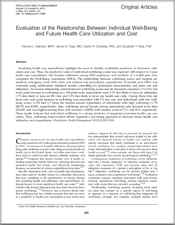Resource:
Evaluation of the Relationship Between Individual Well-Being and Future Health Care Utilization and Cost
Read how escalating health care expenditures highlight the need to identify modifiable predictors of short-term utilization and cost.
Tthe predictive value of individual well-being scores was explored with respect to 1-year health care expenditures and hospital utilization among 2245 employees and members of a health plan who completed the Well-Being Assessment (WBA). The relationship between well-being scores and hospital admissions, emergency room (ER) visits, and medical and prescription expenditures 12-months post WBA was evaluated using multivariate statistical models controlling for participant characteristics and prior cost and utilization. An inverse relationship existed between well-being scores and all measured outcomes ( P £ 0.01). For every point increase in well-being on a 100-point scale, respondents were 2.2% less likely to have an admission, 1.7% less likely to have an ER visit, and 1.0% less likely to incur any health care costs. Among those who did incur cost, each point increase in well-being was associated with 1% less cost, and individuals with low wellbeing scores ( £ 50) had 2.7 times the median annual expenditure of individuals with high well-being ( > 75) ($5172 and $1885, respectively). Also, well-being proved lowest among respondents who incurred more than $20,000, and was highest among those who incurred £ $5000, with median scores of 71.1 and 80.3, respectively. These results indicate that individual well-being is a strong predictor of important near-term health care outcomes. Thus, well-being improvement efforts represent a promising approach to decrease future health care utilization and expenditures. (Population Health Management 2012;15:325–330)
Introduction Current projections are that health care expenditures will account for 20% of the gross domestic product (GDP) by 2016.1 An increase in hospital utilization and prescription drug costs contribute, in part, to the rising economic burden of health care in the United States2 and often stem from conditions such as cardiovascular disease, arthritis, diabetes, and obesity.3,4 Programs that adopt a holistic view of health, including promoting healthy behavior, reducing physical and emotional health risk factors, and effectively maintaining diseases, are projected to reduce expenditures long term.5,6
Specific assessment tools, such as health risk assessments, have been used to identify factors (ie, unhealthy behaviors) that may contribute to the proliferation of chronic disease and escalating health care utilization and expenditures. Although known to incur significant health care costs,3–5 individuals with chronic disease(s) also have been shown to have poorer well-being.7–10 However, less is known about whether well-being may be a holistic measure that also can serve as a predictor of health care expenditure across entire populations. Support for this idea is provided by research that has demonstrated that several outcomes related to the utilization and financial burden of health care correlate with specific measures that likely contribute to an individual’s overall well-being. For example, independent studies have found that utilization is elevated in those who perceive their health as poor11,12; obese patients and those with type 2 diabetes generally have poorer psychological well-being.7,13–15
Contemporary definitions of well-being can be differentiated into 2 broad categories: (1) objective measures of income, life expectancy, GDP, and poverty rates; and (2) subjective measures of a person’s perception of his or her life.16 Subjective well-being can be divided further into 2 areas: evaluative and experienced well-being.17,18 Evaluative well-being assesses emotions associated with past events, whereas experienced well-being assesses emotions associated with events that are currently occurring.17,18
Traditionally, well-being research, including those studies cited, has focused on a specific aspect of well-being as opposed to a measure of well-being that integrates all well-being concepts. For example, multiple studies have quantified well-being in a given population and evaluated how well-being correlates with a defined outcome using the Quality of Well-Being (QWB) scale, which takes into account mobility, physical and social activity, mental health, and symptom status. In these studies, the QWB scale has been shown to be directly related to the severity of chronic obstructive pulmonary disease, arthritis, AIDS, and cystic fibrosis as measured by different methods.9,10,19,20 However, this mode of measurement only includes questions pertaining to objective well-being and does not include subjective components of well-being.
Another study conducted in Sweden by Al-Windi et al stratified patients based on their physical, social, and mental well-being, using a combination of the Go¨tenborg Quality of Life Instrument21 and a ‘‘Complaint Score’’ that evaluates the patient’s perception of well-being.22 Patients with low perceived health scores, a variable in their well-being score, had a greater number of appointments with a physician and higher costs for health care, and the authors hypothesized that health care utilization, in particular outpatient care, is related to the patient’s perception of well-being.22 However, the Al Windi et al study only analyzed health care utilization in the year prior to the questionnaire, and therefore no conclusions can be drawn regarding the predictive value of well-being scores on future outcomes.
In the present study, a global measure of well-being was evaluated in relation to short-term health care utilization and expenditures to determine whether this measure of wellbeing also may serve as a bona fide indicator of these health care measures. Overall well-being was measured using the Well-Being Assessment (WBA) that encompasses evaluative and experienced well-being as well as life evaluation16,23 to provide a comprehensive and quantifiable measure of individual well-being. The results described herein show the relationships between well-being and health care utilization and expenditures and demonstrate that well-being may serve as a predictor of these outcomes.
Download the full whitepaper as published in Population Health Mangement Magazine, Volume 15, Number 6, 2012.

